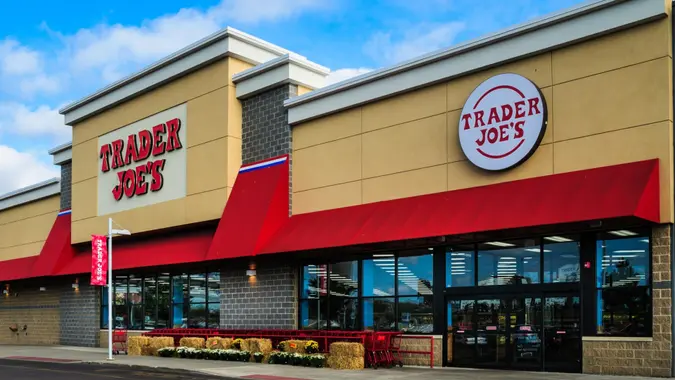How Much Money Do You Receive for One Person on SNAP in 2025?

Commitment to Our Readers
GOBankingRates' editorial team is committed to bringing you unbiased reviews and information. We use data-driven methodologies to evaluate financial products and services - our reviews and ratings are not influenced by advertisers. You can read more about our editorial guidelines and our products and services review methodology.

20 Years
Helping You Live Richer

Reviewed
by Experts

Trusted by
Millions of Readers
The Supplemental Nutrition Assistance Program (SNAP) is America’s largest and most effective anti-hunger initiative. Formerly known as food stamps, the program emerged during the sweeping social reforms of the 1930s.
Today, it serves more than 42 million Americans at risk of malnutrition, according to the United States Department of Agriculture (USDA), or around 12.6% of the population. Roughly 40% of recipients are children, but many are single adults.
The USDA, which administers SNAP in conjunction with the states, has strict eligibility guidelines regarding income and household size. The department adjusts those guidelines annually for inflation, along with the maximum monthly payment households can receive.
Here’s how much an individual SNAP recipient can receive in 2025.
SNAP Benefits and Eligibility Criteria for Individuals
Every year, the USDA calculates the maximum monthly SNAP benefit based on its Thrifty Food Plan, one of four plans the department created to outline the cost of achieving a healthy diet across successively higher price points. The other three are the Low-Cost, Moderate-Cost and Liberal Food Plans.
In fiscal year 2025, which runs through September, the maximum monthly SNAP benefit for a single-person household is $292, just one dollar more than the previous year.
Benefits According to Household Size and Income
SNAP refers to its monthly benefits as “allotments,” which it calculates with the expectation that recipients will spend 30% of their own income on food. It determines allotments by multiplying a household’s net monthly income by 0.3, and then subtracting that amount from the maximum monthly allotment for that household size, which in the case of a single person in 2025, is $292.
For example, if a person has a net income of $200 per month, the expected contribution is $60 (30% of $200). The allotment would be the maximum amount ($292) minus the recipient’s contribution ($60), totaling a monthly benefit of $232.
Income Eligibility Criteria
To receive benefits, applicants must apply in the state where they currently live, and earn an income that falls within SNAP’s eligibility guidelines.
The program outlines thresholds for both gross and net monthly income. Gross income is the total earnings before eligible deductions, which you’ll read about shortly. Net income is what’s left over after all allowable deductions are subtracted. Most households must meet both the net and gross income requirements.
An individual applicant must earn 130% of the poverty line or less in gross monthly income to qualify. For fiscal year 2025, that’s roughly $1,632 per month. The same applicant can earn no more than 100% of the federal poverty line, or $1,255, in monthly net income.
Deductions and Assets
SNAP subtracts various deductions from a recipient’s gross income to determine that person’s net income. These include a standard deduction of $204 for households with between one and three members in most states, an earnings deduction of 20% of earned income, shelter costs exceeding half of the net income after other deductions, and others. These deductions reflect the portion of the applicant’s income that is unavailable for food expenses.
For 2025, SNAP allows assets worth up to $3,000 in countable resources, like cash or money in a bank account, or up to $4,500 if at least one household member is disabled or 60 or older.
Homes and lots, SSI income and TANF payments do not count, while vehicles, retirement accounts and pension funds may or may not count, depending on the circumstances.
Factors That Influence Monthly Payments
The final payment will vary depending on an applicant’s income, assets, household size and deductible expenses. Lower-income recipients can receive higher benefits closer to the maximum monthly allotment, as can those with burdensome housing costs.
SNAP benefits are adjusted annually for inflation. This means that the maximum and average benefits can change each fiscal year.
More Information About SNAP
Individuals interested in applying for SNAP should contact their local human services office or state agency. These offices can provide guidance on eligibility and help with the application process.
For current recipients, it’s important to report any significant changes in income or expenses, such as a job loss or increased housing costs, to their state agency, as those changes can impact the benefit amount. Besides SNAP, people in need can seek assistance from local food banks and other community resources for immediate food assistance.
Conclusion
SNAP plays a vital role in supporting individuals facing food insecurity. For a single person, understanding how the USDA calculates benefits and what factors influence the amount received can be crucial in ensuring they receive the appropriate level of assistance. The program’s design reflects a balance between the individual’s income and their food-related expenses, aiming to provide adequate nutritional support.
 Written by
Written by  Edited by
Edited by 

























